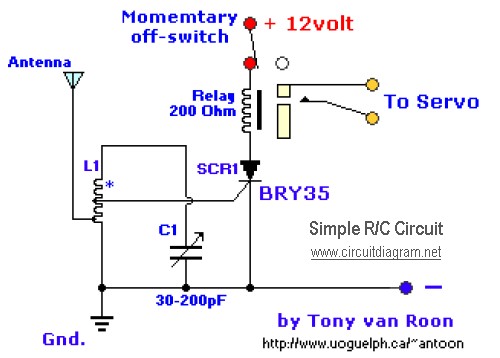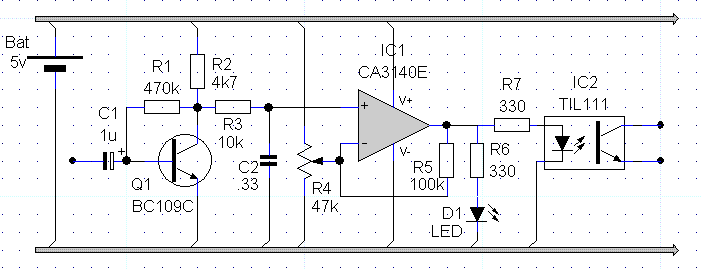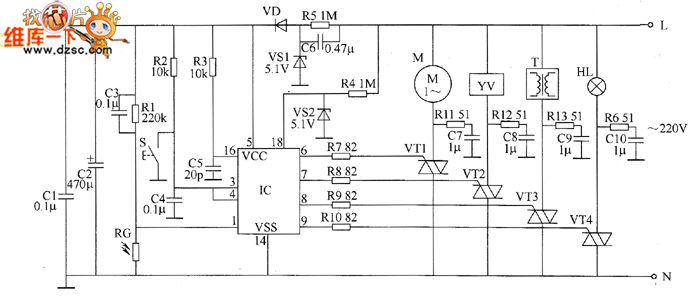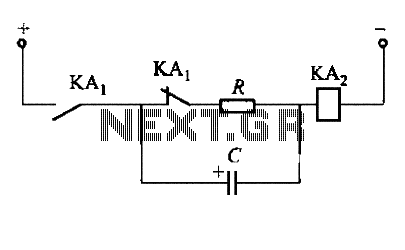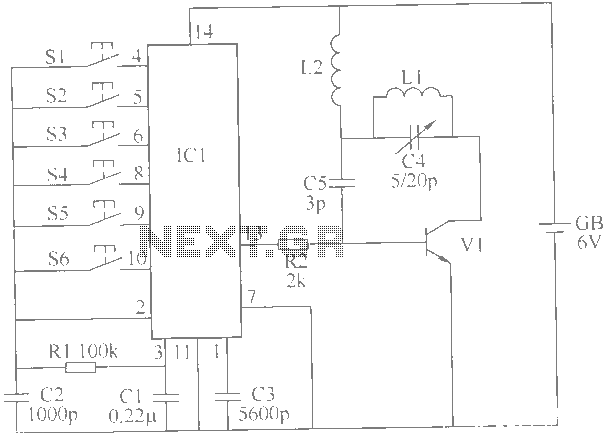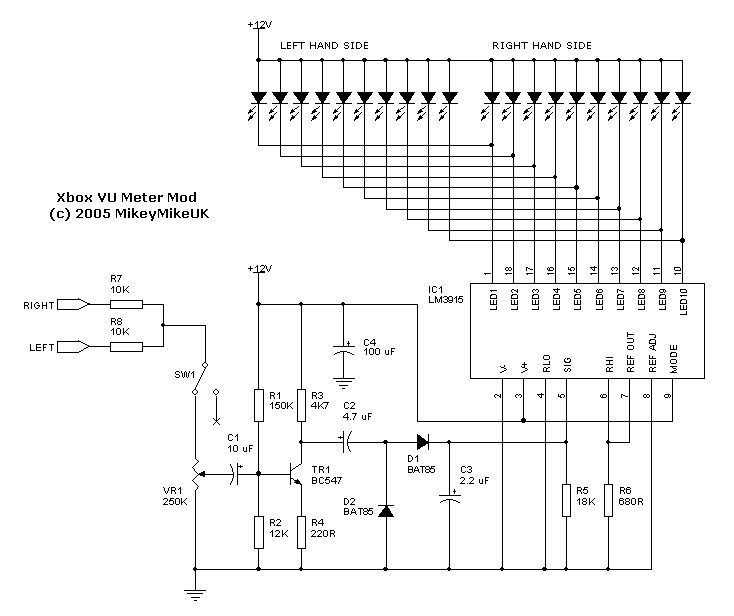
Antenna selector circuit diagram electronic project
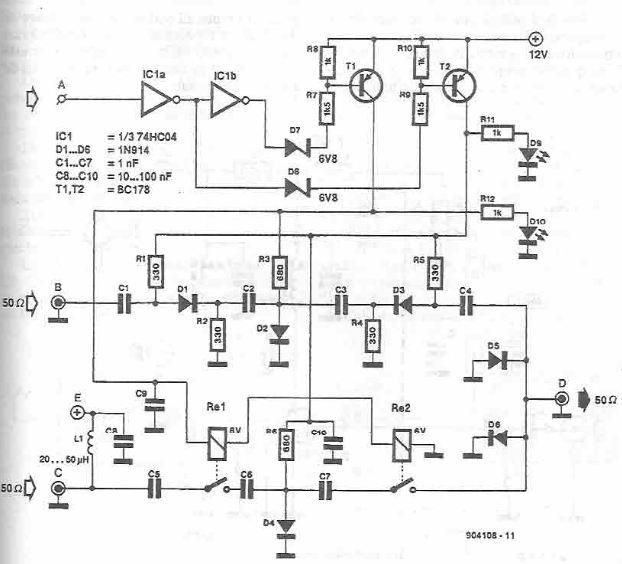
This antenna selector circuit diagram electronic project is constructed using standard electronic components and facilitates the switching between two FM antennas through a logic signal. The gates IC1b and IC1a manage the switching and interface between the required logic levels of 5V and 12V for selection. When input A is in a high logic state, the output of IC1a will be low, while the output of IC1b will be high. In this scenario, current will flow from the positive supply terminal to IC1a, passing through T2, R9, and D8; subsequently, T2 will lead to D9 lighting up. Conversely, when input A is in a low logic state, IC1b will also be low, causing current to flow from the source to the positive connector of IC1b, through Q1, R7, and D7, which will turn T1 on and illuminate D10. Meanwhile, the two relays, RE1 and RE2, connected in series, will be energized, closing their contacts and allowing a VHF signal to appear at the C input and D output.
This antenna selector circuit employs a straightforward design that leverages common electronic components to enable effective antenna switching. The circuit utilizes two integrated circuit gates (IC1a and IC1b) to control the logic states required for the operation of the relays, which are responsible for selecting the desired antenna. The logic signals dictate the flow of current through the circuit, ensuring the appropriate relay is activated based on the input state.
In the high logic state of input A, the circuit is designed to route power through T2, which is a transistor that acts as a switch. When activated, T2 allows current to flow through R9 and D8, illuminating D9, which serves as an indicator that the first antenna is selected. This configuration ensures that the first relay (RE1) is energized, allowing the signal from the first FM antenna to pass through to the output.
In contrast, when input A is in a low logic state, the circuit activates T1 instead. This transistor's activation occurs through the pathway of Q1, R7, and D7, which also serves as an indicator by lighting D10. The activation of T1 energizes the second relay (RE2), allowing the second FM antenna to connect to the output. The series configuration of the relays ensures that only one antenna can be selected at a time, preventing signal interference.
The circuit is powered by a dual voltage supply, with 5V and 12V levels necessary for the operation of the logic gates and transistors, respectively. The careful design of the circuit ensures that it can operate reliably in a variety of conditions, making it suitable for applications where antenna selection is needed without manual intervention. The use of common components also facilitates easy assembly and repair, enhancing the practicality of the project for hobbyists and professionals alike.This antenna selector circuit diagram electronic project is designed using common electronic components and allows switching between two FM antennas via a logic signal. Gates IC1b and IC1a provide switching and interface between the logical form of 5 and 12 V supply voltage, required for selection.
When input A is logic state H, IC1a`s output will be L and that of IC1b will be H. In this case, current will flow from the positive supply terminal to IC1a, through T2 R9 and D8; T2 lead and D9 light. When input A is logic state L, then IC1b is L, the current flow from source to IC1b positive connector, through Q1, R7 and D7, then T1 is open and D10 light.
Meanwhile, the two relays connected in series, RE1 and RE2, are placed under voltage, their contacts close and VHF signal appear at C input and D output 🔗 External reference
This antenna selector circuit employs a straightforward design that leverages common electronic components to enable effective antenna switching. The circuit utilizes two integrated circuit gates (IC1a and IC1b) to control the logic states required for the operation of the relays, which are responsible for selecting the desired antenna. The logic signals dictate the flow of current through the circuit, ensuring the appropriate relay is activated based on the input state.
In the high logic state of input A, the circuit is designed to route power through T2, which is a transistor that acts as a switch. When activated, T2 allows current to flow through R9 and D8, illuminating D9, which serves as an indicator that the first antenna is selected. This configuration ensures that the first relay (RE1) is energized, allowing the signal from the first FM antenna to pass through to the output.
In contrast, when input A is in a low logic state, the circuit activates T1 instead. This transistor's activation occurs through the pathway of Q1, R7, and D7, which also serves as an indicator by lighting D10. The activation of T1 energizes the second relay (RE2), allowing the second FM antenna to connect to the output. The series configuration of the relays ensures that only one antenna can be selected at a time, preventing signal interference.
The circuit is powered by a dual voltage supply, with 5V and 12V levels necessary for the operation of the logic gates and transistors, respectively. The careful design of the circuit ensures that it can operate reliably in a variety of conditions, making it suitable for applications where antenna selection is needed without manual intervention. The use of common components also facilitates easy assembly and repair, enhancing the practicality of the project for hobbyists and professionals alike.This antenna selector circuit diagram electronic project is designed using common electronic components and allows switching between two FM antennas via a logic signal. Gates IC1b and IC1a provide switching and interface between the logical form of 5 and 12 V supply voltage, required for selection.
When input A is logic state H, IC1a`s output will be L and that of IC1b will be H. In this case, current will flow from the positive supply terminal to IC1a, through T2 R9 and D8; T2 lead and D9 light. When input A is logic state L, then IC1b is L, the current flow from source to IC1b positive connector, through Q1, R7 and D7, then T1 is open and D10 light.
Meanwhile, the two relays connected in series, RE1 and RE2, are placed under voltage, their contacts close and VHF signal appear at C input and D output 🔗 External reference
Warning: include(partials/cookie-banner.php): Failed to open stream: Permission denied in /var/www/html/nextgr/view-circuit.php on line 713
Warning: include(): Failed opening 'partials/cookie-banner.php' for inclusion (include_path='.:/usr/share/php') in /var/www/html/nextgr/view-circuit.php on line 713
